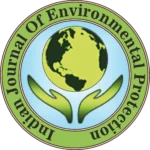IJEP 45(3): 283-292 : Vol. 45 Issue. 3 (March 2025)
Veeramani S.1*, Suyog Subashrao Patil2, P.J. Suhyb2, Eby Varghese3, Ashna Nassar3 and Reshma Rajendran3
1. Periyar Tiger Conservation Foundation, Periyar Tiger Reserve (East Division), Idukki – 685 509, Kerala, India
2. Periyar Tiger Reserve (East), Periyar Tiger Reserve, Idukki – 685 509, Kerala, India
3. Kerala Pollution Control Board, Idukki – 685 584, Kerala, India
Abstract
Surface water is an inevitable source of water, so we selected our project as a surface water quality assessment of Periyar lake using geopraphical information system (GIS). The study area, Periyar lake, lies 9°28′ to 9°35′ N latitude and 77°8′ to 77°17′ E longitude and spreads over 26 km2 is a vital source of water to residents, wildlife and farmers in Idukki, Theni, Madurai, Ramanathapuram districts. The advancement in GIS and spatial analysis helps to integrate laboratory analysis data with geographic data and to model the spatial distribution of water quality. The main objective of this study is to determine the spatial variability of surface water quality using GIS. A total of 16 water samples were collected from different locations throughout the study area with the help of GPS. The physico-chemical parameters of the samples were determined from different locations in Periyar lake. Sample lake location is obtained using GPS and the locations are imported into quantum GIS to create a point feature. Spatial maps were generated in GIS by interpolation of the inverse distance weighted technique. From the results, it is concluded that the water quality of the lake is within the permissible limits. The few inlet points of the lake are polluted because of the wastewater from nearby settlements.
Keywords
Surface water quality, Inverse distance weighted method, Periyar lake, Geopraphical information system
References
- Kanniyappan, S.P., D.P. Raguraj and E. Vignesh-waran. 2016. Physico-chemical analysis of ground and surface water in Cuddalore district due to effect of 2015 monsoon. Adv. Appl. Sci. Res., 7(4): 176-184.
- Panda, S.S., V. Garg and I. Chaubey. 2004. Artificial neural networks application in lake water quality estimation using satellite imagery. J. Env. Inf., 4(2): 65-74.
- Brindha, G. 2013. Emerging trends of telemedicine in India. Indian J. Sci. Tech., 6(5): 4572-4578.
- Ashraf, M.A. and M.M. Hanafiah. 2017. Recent advances in assessment on clear water, soil and air. Env. Sci. Poll. Res., 24: 22753–22754.
- Ferrier, R.O.C., et al. 2018. Water quality of Scottish rivers: spatial and temporal trends. Sci. Total Env., 265: 327–342.
- Carpenter, S.R., et al. 1998. Non-point pollution of surface waters with phosphorus and nitrogen. Ecol. Appl., 8: 559–568.
- IS 10500. 1991. Drinking water standards- Specification. Bureau of Indian Standards, New Delhi.
- Alaguraja, P., et al. 2010. Remote sensing and GIS approach for water pollution and management in Thiruchirapalli taluk, Tamil Nadu. Int. J. Env. Sci., 1(1): 66-70
- APHA. 1985. Standard methods for the examination of water and wastewater. American Public Health Association, New York.
- Menon, S.Y. and K.S. Bawa. 1997. Applications of geographical information systems, remote sensing and landscape ecology approach to biodiversity conservation in the Western Ghats. Curr. Sci., 73: 134-145.
- Shalaby, A. and R. Tateishi. 2007. Remote sensing and GIS for mapping and monitoring land cover and landuse changes in the northwestern coastal zone of Egypt. Appl. Geol., 27: 28-41.
- Sargaonkar, A. and V. Deshpande. 2003. Development of an overall index of pollution for surface water based on a general classification scheme in indian context. Env. Monit. Assess., 89(1): 43-
67. - Panwar, A., et al. 2015. Water quality assessment of river Ganga using remote sensing and GIS technique. Int. J. Adv. Remote Sens. GIS. 4(1): 1253-1261.
- Lane, R.R. and J.W. ray. 1999. Water quality analysis of a freshwater diversion at Caernarvon, Louisiana. J. Coastal Estuarine Res. Fed., 22(2): 327-336.
- Alssgeer, H.M.A., et al. 2018. GIS-based analysis of water quality deterioration in the Nerus river, Kuala Terengganu, Malaysia. Desalination Water Treat., 112: 334–343.
